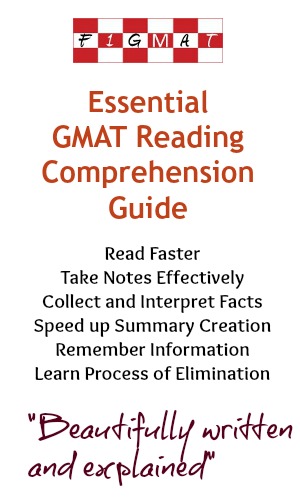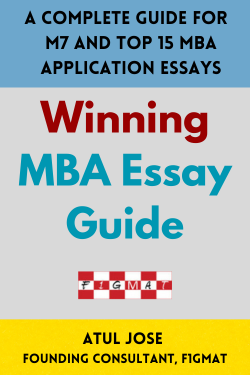Although we recommend that test takers go back to the passage for facts or questions related to “quotes,” memory serves the crucial role of understanding the author’s point of view. Skim the passage when the questions are about “the main idea,” “tone,” “passage structure,” and “author’s stand,” but without comprehending the author’s point of view, reading in record time becomes a wasteful exercise.
You cannot improve your memory with a 3-month GMAT preparation, but you can improve with these four focus areas:
1) Motivation
When you perform any activity – reading or writing, the motivation to do it efficiently, influences your concentration. If you look at GMAT as a roadblock for completing the MBA application process, you are less likely to score in the competitive range. Instead, look at GMAT as a tool to solidify your position among the probable candidates, before the admission team evaluates essays, recommendation letters, and interview performance. This small shift in approach drastically changes your outlook towards reading GMAT passages, even if that means reading some of the most boring texts about coral reefs, or a scientific phenomenon that you don’t care.
2) Remembering Irrelevant Information
Authors not only plug in irrelevant facts and distract the GMAT test taker, but they use multiple arguments to convey the main idea, and not all the points are relevant for the questions asked. Read the questions before reading the passage. This will save time.
Read this passage
<Start of Passage>
The National Association for the Advancement of Colored People (NAACP) had fought since 1909 to end discrimination with peaceful tools such as lawsuits, education, and political lobbying. Those efforts didn’t have any visible effect until the Supreme Court’s landmark Brown v. Board of Education (1954) case that overturned the facile "separate but equal" doctrine. One by one, schools slowly implemented the ruling. What the law decreed the state could not implement, and schools remained segregated. On December 1, 1955, Rosa Parks refused to get up from her seat on a public bus for a white passenger. She was arrested, but her adamancy kicked off the civil disobedience movement. Martin Luther King Jr took up the baton and used his immense oratorical skills to promote the nonviolent tactics used by Mahatma Gandhi. A plethora of disobedience incidents culminated in the 200,000-strong August march in Washington, leading up to the historic “I have a dream" speech. The Civil Rights Act of 1964 that outlawed segregation and racial discrimination was soon passed.
Did Barack Obama’s reelection on 7th November 2012 finally mark the rise of the new America? The first re-election can be dismissed as an anti-incumbency vote against Bush. But when an African American President stood on the victory step for the second time, it must surely count as a recognition of the fact that all the efforts of the Civil Rights Movement headed by Martin Luther King have borne fruit. Perhaps!
In 1984, 73% of whites aged 65 and above earned incomes from assets, compared to 31% of blacks and 38% of Hispanics. In 1998, the figures were 69%, 26% and 33%. The 2009 median wealth of white households was $113,149, Hispanic households at $6,325 and that of black households at $5,677. Arguably, the biggest indicator of whether Americans have grown beyond race has been the recent statement by the presidential hopeful Mitt Romney, who said, “There are 47 percent of the people who will vote for the president no matter what. All right, there are 47 percent who are with him, who are dependent upon government, who believe that they are victims. These are people who pay no income tax." Is it covert racism, or an insensitive gaffe?
b) Suggest that racism has become irrelevant in modern America
c) Provide historical context and measures taken by NAACP to fight racism
d) Show that equality is yet to be attained.
e) Provide evidence that African Americans are still segregated in society
2) The author quotes Mitt Romney to hint that
b) People are evading tax by supporting Obama
c) Income inequalities exist in American society especially among minorities
d) The insensitive remark cost Mitt Romney the 2012 election
e) The assumption made by Mitt Romney was wrong
b) Great Migration
c) Brown v. Board of Education Supreme Court Case
d) Civil Rights Movement
e) Passing the 13th Amendment
b) It poses a question and hints at a negative observation
c) It makes a general observation
d) It provides statements to support arguments mentioned in the preceding paragraphs
e) It cites recent events to explain a phenomenon
5) The attitude of the author towards Obama’s reelection is one of
b) Explicit Support
c) Implicit Support
d) Marked Suspicion
e) Opposition
Now let us look at the answers one by one.
Answers
When you start reading a passage, guess the author’s stand. Is he for or against a subject? Passages used in GMAT reading comprehension are opinion pieces on historical events and political movements or fact-based scientific passages. Once you guess the stand, reading complex arguments becomes interesting, and you will evaluate the structure of the passage, and the adjectives used by the author. The phrases reveal the attitude of the author and confirm or reject your theory on where the author stands on the subject.
4) Association
Mnemonics have helped Medical students remember complex biological names, but you don’t have to go that far. In a computer Adaptive test like the GMAT, word-by-word recall is not necessary. It is the ideas that count.
Ptolemy's theory = Toll’s theory
Copernican theory = Copper Theory
Example: According to Ptolemy's theory, Earth was the center of the planetary system, and the planets & the sun circled the earth. Copernicus later challenged this theory with accurate observations devoid of any outlandish assumptions to prove the contrary.
Those who read incrementally, accumulating information in an easily digestible format, can create idea association like:
Toll’s theory = Earth Center
Copper Theory = Sun Center


